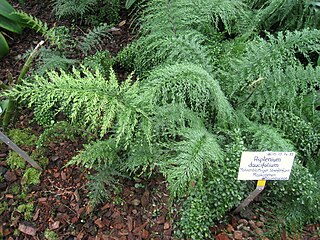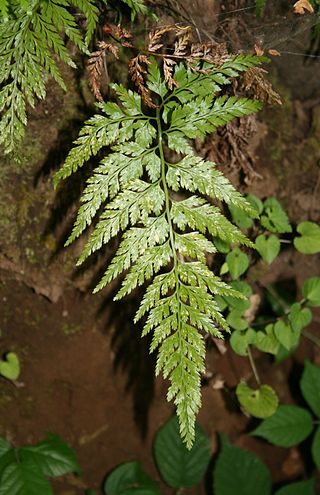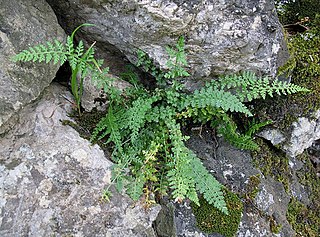Asplenium ruprechtii, which goes by the common name Asian Walking Fern, is a rare, hardy, low-lying fern native to East Asia. It is a close relative of Asplenium rhizophyllum which is found in North America and also goes by the common name of walking fern. The species should not be confused with Asplenium sibiricum which is a synonym of Diplazium sibiricum.

Asplenium ceterach is a fern species commonly known as rustyback.

Asplenium septentrionale is a species of fern known by the common names northern spleenwort and forked spleenwort. It is native to Europe, Asia and western North America, where it grows on rocks. Its long, slender leaves give it a distinctive appearance. Three subspecies exist, corresponding to a tetraploid and a diploid cytotype and their triploid hybrid.

Asplenium vespertinum is a species of fern known by the common name western spleenwort. It is native to southern California and Baja California, where it grows in moist, shady, rocky places, such as the shadows beneath cliff overhangs.

Asplenium flaccidum is a species of fern in the family Aspleniaceae. The plant common name is drooping spleenwort or weeping spleenwort, and the species name flaccidum derives from the Latin root meaning drooping. An example occurrence of A. flaccidum is within a Nothofagus-Podocarp forest at Hamilton Ecological District on New Zealand's North Island in association with other fern species understory plants, crown fern, Blechnum discolor being an example.

Asplenium azoricum is a fern from hybrid origin of the family Aspleniaceae, descendant of the Macaronesian ancestral fern Asplenium anceps. It lives exclusively in the Azores, that is a strict endemic Azorean fern. Its fronds are coriaceous like plastic and its rachis is very thick, dark garnet color and brilliance. A typical feature of this fern, which it shares with all the descendants of A. anceps, is the existence of a small atrium at the base of the medium and lower pinnae geared towards the apex of the frond with one or two sori in its underside.

Asplenium antiquum is a fern of the group known as bird's-nest ferns. In Japanese it is known by ō-tani-watari and tani-watari. It grows on cliffs, in dark forests, and on tree trunks in China, Japan, Korea, and Taiwan. It is classified as an endangered species in both South Korea and Japan.

Asplenium ruta-muraria is a species of fern commonly known as wall-rue. It is a very small epipetric species, growing exclusively on limestone and other calcareous rocks. Its fronds are bluish-green and are heavily sub-divided, becoming up to 12 cm in length.

Asplenium daucifolium is a species of fern in the family Aspleniaceae, endemic to the Mascarene Islands.

Asplenium dimorphum, the Norfolk Island spleenwort, is a species of fern in the family Aspleniaceae, endemic to Norfolk Island.

Asplenium goudeyi is a fern only found on Lord Howe Island. A common plant growing in a variety of situations. On trees, or rocks, boulders, cliff faces and sometimes in exposed positions. The wavy edged fronds are 50 to 75 cm long, and 12 to 18 cm wide.

Asplenium viride is a species of fern known as the green spleenwort because of its green stipes and rachides. This feature easily distinguishes it from the very similar-looking maidenhair spleenwort, Asplenium trichomanes.

Asplenium adiantum-nigrum is a common species of fern known by the common name black spleenwort. It is found mostly in Africa, Europe, and Eurasia, but is also native to a few locales in Mexico and the United States.

Asplenium onopteris, known as the Irish spleenwort or western black spleenwort, is a species of fern mostly found throughout the Mediterranean Basin but also around the Eastern Atlantic.

Asplenium milnei is a ground fern only found on Lord Howe Island. Commonly seen in lowland areas.
Asplenium pteridoides is a species of terrestrial fern in the family Aspleniaceae. It is endemic to Australia's subtropical Lord Howe Island in the Tasman Sea. It is restricted to the cool, moist understorey of the forest on the island's southern mountains.

Asplenium surrogatum is a species of fern in the family Aspleniaceae. It is endemic to Australia's subtropical Lord Howe Island in the Tasman Sea. It grows both terrestrially and as an epiphyte. It occurs in forest at high elevations on the island's mountains.

Asplenium appendiculatum, ground spleenwort, is a common native fern to Australia and New Zealand. It usually grows in cool damp conditions, among rocks, on logs or as an epiphyte.

Asplenium fontanum, commonly known as fountain spleenwort or smooth rock spleenwort, is a species of fern in the family Aspleniaceae, native to rocky areas in Western Europe.
Asplenium haughtonii, also known as the Barn fern, is a species of fern in the family Aspleniaceae. It is native to Saint Helena.

















